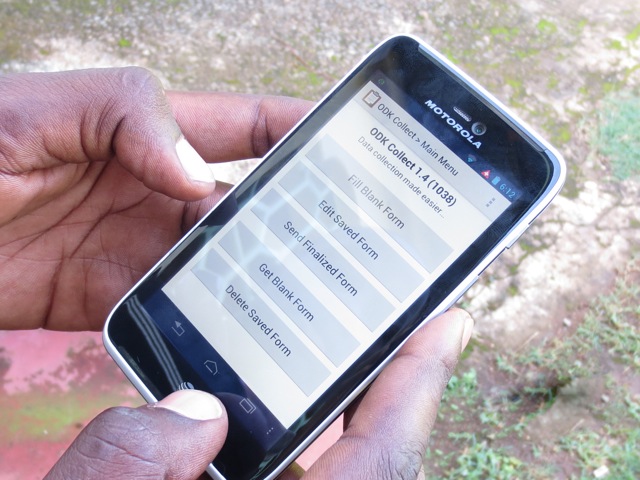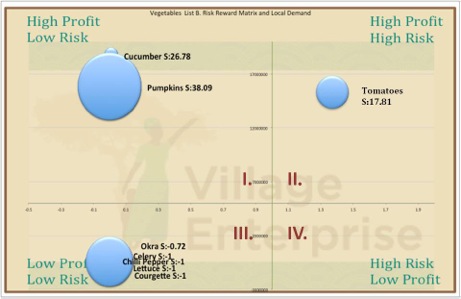SMART-er Ways to Plant Profitable Crops
When you’re a subsistence farmer in drought-stricken regions of East Africa, gambling on what crop to plant is a life-and-death wager for your family.
Small-scale farmers like Ugandan farmer Ongica Vicent, can now make much safer (and wiser) business decisions that help him and his family of eight move out of extreme poverty in a region expected to see continued, crippling droughts. Vicent used a new mobile-enabled system developed at Village Enterprise, where I am director of programs and field finance, to successfully focus on growing sesame, called “simsin” in Africa as opposed to a range of other, less profitable crops.
“We are doing much better than other business owners,” he recently told me.
Vicent and two fellow business owners saw increased profits of $1,367 over the previous season. Vicent was better able to feed his family and had enough money left over to purchase a cow, a calf, two sheep, clothing and shoes.
At Village Enterprise, we’re committed to equipping people living in extreme poverty in Africa with all the resources they need to start sustainable businesses. While we are based in the Silicon Valley, the pinnacle of tech innovation, we act much like an early-stage angel investor, providing small grants for first-time entrepreneurs living in on less than $1.25 a day.
In 2013, Village Enterprise a nonprofit organization with a history of 25 years of rural development, funded more than 2,100 businesses and provided business training and mentoring to more than 6,300 first-time entrepreneurs in Uganda and Kenya.
The Limiting Factor: Access to information
Working in extremely remote communities, where most viable businesses are agriculture related, it’s obvious how these critical factors hold people in extreme poverty. A lack of infrastructure including roads and electricity grids, land, food, and healthcare are all barriers to economic growth. But we focus on another critical scarcity: access to information.
Our business owners have extremely limited access to knowledge and information that keep them from accessing economic opportunities. Without information to help make more profitable and productive farming decisions, farmers rely on less-lucrative, traditional practices passed down through generations and friends. These same practices may not ever yield profits and keep farming families locked in extreme poverty.
The SMARTer Solution
 The solution developed, SMART: Smarter Market Analysis Risk Tool, provides an extensive, village-level market analysis of the various choices available to our clientele.
The solution developed, SMART: Smarter Market Analysis Risk Tool, provides an extensive, village-level market analysis of the various choices available to our clientele.
To develop SMART, our staff, which is 98 percent African, used Android phones donated by Motorola to capture price, risk, and demand data from local village markets, information from expert agronomists on seed, pests, and other inputs to agriculture, and “best practices” from local farmers.
The results are a powerful risk/reward matrix that can be understood by farmers with low levels of education, providing more certainty when making business decisions. For example, using SMART, farmers in Kenya and Uganda could see that planting cucumbers and pumpkins would yield higher profits than planting traditional okra and celery.
What being SMART Looks Like
Here is why we believe SMART has become a game-changer the past two years for our Village Enterprise model, which has helped launch more than 27,000 businesses and trained more than 130,000 business owners since its inception. We work with rural Kenyans and Ugandans to start new businesses three times a year: in February, June, and October. Our local business mentors lead 30-member business groups through an extensive selection and planning process. For the first time, this year SMART allowed our entrepreneurs to use real-time information to make more intelligent decisions about which business to pursue for maximum profitability in their markets.
Our 2013 program evaluation yielded impressive results: At the end of the 12-months, the average daily consumption (or household spending) of our business owners in both Kenya and Uganda increased by 75 percent.
A distinguishing factor between SMART and other NGO-created market-to-farmer pricing communication tools is that Village Enterprise targets a clientele historically underserved by the majority of NGOs.
Most similar tools take price data from larger, more lucrative town centers and broadcast this information to farmers throughout the region. Even our closest businesses are located several kilometers away from larger towns and do not have the means to transport themselves or their products. We collect data at a village-market level – the markets that our clientele can reliably access.

Village Enterprise is funded equally through individual and institutional donors. SMART is a module within the core VE curriculum, so all business owners are trained on the SMART methodology and exposed to the SMART outputs. A livestock and retail SMART product is currently under development.
It’s gratifying to see SMART at work in lives like this. And we’re proud that SMARThas been recognized by the international community for its innovation and its ability to be used as a resource to alleviate poverty. In 2013, Rockefeller Foundation recognized it as one of the top 100 Next Century Innovators. By 2015, about 9,000 people in Uganda and Kenya will have access to SMART. We’re also developing a livestock and retail SMART product. We’re even more excited to see this mobile technology momentum continue to help thousands more people leave extreme poverty behind.
(A matrix charts risk/reward scenarios for various crops).
Ellen Metzger is director of programs and field finance for Village Enterprise
- Categories
- Agriculture, Technology
